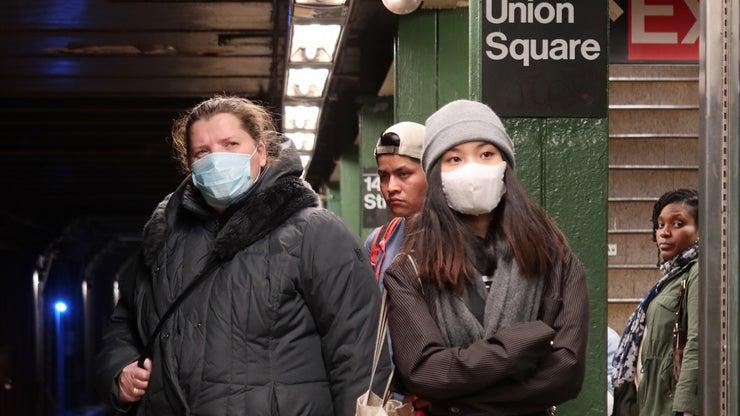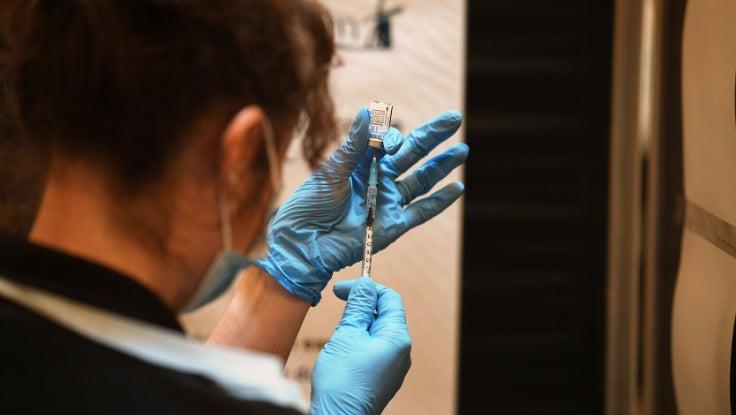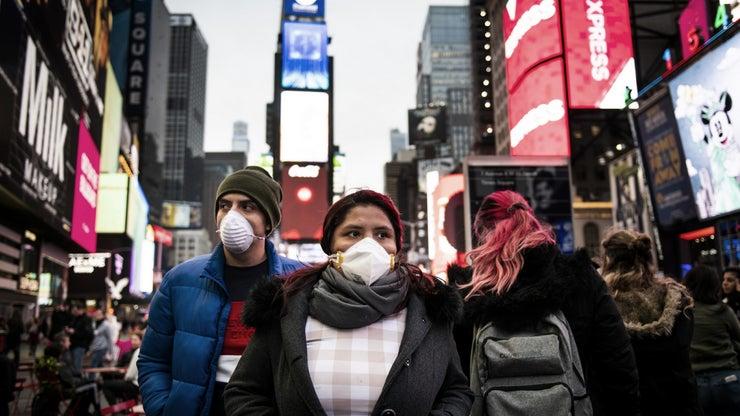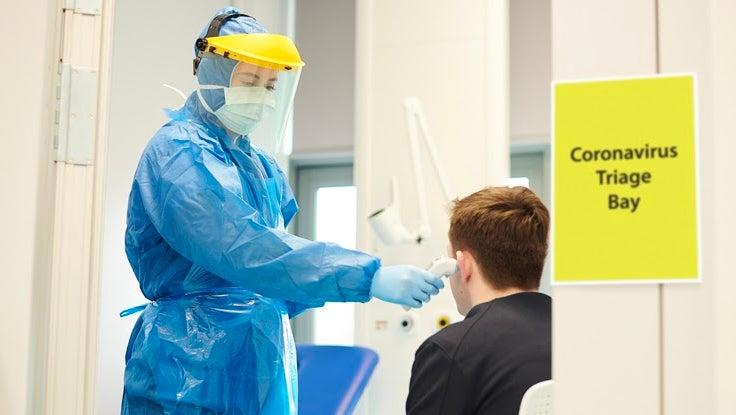what its like to be in a long term relationship

The COVID-19 pandemic has introduced a boundless amount of unfamiliar terms and phrases into our everyday lives. Though they can be confusing, it's important to take an accurate understanding of their meanings, especially if nosotros want our communities to navigate the pandemic safely. Below, we've rounded upward some of the well-nigh common COVID-nineteen-related terms — from how the virus spreads in communities, to treatment and examination options to how to help tiresome the spread. Without a doubt, familiarizing yourself with this list is the showtime step to ensuring a safer tomorrow for yourself and others.
Virus- & Outbreak-Related Terms
- Coronavirus: There are many types of coronaviruses, all of which contain RNA and have crown-shaped spikes on their surfaces. Different types of these viruses tin cause mild affliction similar the mutual cold, or more severe respiratory infections.
- SARS-CoV-2 or the "novel coronavirus": These are both terms for the coronavirus that has caused the COVID-nineteen pandemic. Because this item virus was novel to humans, there was no existing amnesty or ability to fight off the virus' furnishings.
- COVID-19: the name of the affliction that SARS-COV-2 can cause. COVID-19 is a shortened version of "coronavirus disease 2019."

- Zoonotic: A description of a disease that is able to spread from animals to humans. Co-ordinate to the Heart for Disease Control and Prevention (CDC), zoonotic diseases are relatively common — 6 out of 10 of all known diseases are zoonotic.
- Outbreak: A localized uptick in cases. Outbreaks are often traceable to specific events like concerts, or locations like day care centers or nursing homes.
- Epidemic: A larger than expected surge in the number of cases of a disease or disease in a item geographic region or area.
- Pandemic: An epidemic that has spread across geographical or national boundaries and has affected a large number of people on a global scale. COVID-nineteen was declared a pandemic on March 11, 2020.
Manual- & Spread-Related Terms
- Airborne Transmission: A affliction or illness that can be spread from person to person through the air. Airborne diseases tend to exist more contagious than those requiring physical contact.
- Aerosol: A tiny particle of respiratory fluid that contains viral material and can remain in the air for a period of time.
- Droplet: A small driblet of fluid. Aerosol containing a virus can be expelled when an infected person talks, breathes, sneezes, or coughs.

- R0/'R-nothing': A number indicating the average number of people that volition take hold of a disease or disease from one infected person. R0 is used equally a measure of how contagious a disease is. The R0 for COVID-19 transmission in the U.s.a. varies by region.
- Community Transmission: This refers to cases of infection that cannot exist directly linked to known travel of an individual or a previously identified positive instance.
- Asymptomatic: When ane is displaying no symptoms or outward signs of having a disease throughout the course of infection. Evidence suggests that individuals who are asymptomatic can even so transmit the virus to others.
- Presymptomatic/Incubation Period: When one is not however displaying symptoms due to an early stage of infection. The virus can still be spread during this fourth dimension menstruation.
- Super-spreader: A person who transmits a affliction or illness to an unusually high number of people.
Prevention- & Mitigation-Related Terms
- Social and Physical Distancing: The exercise of reducing shut person-to-person contact in a community in order to decrease the transmission rate of a virus or illness. Social distancing measures include instructions to work from home, plexiglass barriers, or half dozen-foot markers in public spaces.
- Contact Tracing: The process of public health officials identifying individuals who have been infected with or exposed to a viral illness in order to further mitigate and manage the virus'due south spread inside a customs.
- Flattening the Curve: The "curve" here refers to the shape on graphs like number of cases or hospitalizations. 'Flattening' these curves involves taking steps like sheltering in place, social distancing, and self quarantining in lodge to prevent surges of patients that demand hospitalization and treatment all at once.

- Personal Protective Equipment (PPE): PPE refers to wearable or materials that are particularly made to act as a barrier against exposure or infection. Examples of PPE include face up shields, masks, goggles, gowns and gloves.
- N95: Also called a respirator, this special type of mask covers the nose and mouth and is manufactured to safely filter particles that tin cause COVID-19 when fit-tested and used correctly. These masks are typically reserved for healthcare workers or those coming in close contact with active infection, and are not recommended for use in public.
- Quarantine/Cocky-Quarantine: A quarantine is a period of isolation following exposure or potential exposure to a virus, in order to prevent passing the virus to others. Individuals who accept been potentially exposed to COVID-xix are advised to quarantine for at least ten days following the exposure.
- Isolation/Self-Isolation: When an individual has a confirmed or suspected example of an illness or virus, they should isolate. Isolation differs from quarantine in that quarantine occurs following potential exposure to an disease, and isolation occurs later on an individual has been infected.
- Vaccine: Vaccinations introduce a small amount of inactivated or weakened virus so that the body can produce antibodies that work by recognizing the virus and preventing it from causing disease in the future. Vaccines are preventative measures that can increase amnesty on a large scale.
Testing- & Handling-Related Terms:
- Molecular or Viral Test: A test used to determine if a person currently has an active infection from SARS-CoV-2. Viral tests work by analyzing a sample of saliva or mucus in order to make up one's mind whether the virus is present.
- Antibiotic Test: A examination that detects whether a person has antibodies for a specific virus or illness. Antibodies are proteins created past the body's immune system that gainsay a specific virus or disease. These tests are not used to option up on active infections.

- Remdesivir (Veklury): An antiviral drug that has been approved past the FDA for treatment of COVID-xix. Remdesivir works past preventing replication of RNA within viral particles and then that the virus cannot multiply and spread within the body as hands.
- Dexamethasone: A corticosteroid with anti inflammatory and immunosuppressive effects, often used to combat respiratory illness. Dexamethasone is recommended as a treatment for moderate to severe COVID-nineteen to piece of work against tissue damage in the lungs.
- Ventilator: When a patient isn't able to breathe on their own, a ventilator can be used in the hospital to assistance them breathe. A tube is inserted into the patient's windpipe through the oral cavity and a machine works to supply oxygen directly to the patient's lungs.
Resource Links:
- Coronavirus (COVID-19) Outbreak Glossary via Kaiser Family Foundation (KFF)
- COVID-19 Glossary via Yale Medicine
- "Zoonotic Diseases" via Centers for Disease Control & Prevention (CDC)
- "Testing Overview" via Centers for Disease Control & Prevention (CDC)
- "Data for Clinicians on Investigational Therapeutics for Patients with COVID-19" via Centers for Disease Control & Prevention (CDC)
- "Scientific discipline Cursory: SARS-CoV-2 and Potential Airborne Transmission" via Centers for Disease Command & Prevention (CDC)
- "Concluding report confirms Remdesivir benefits for COVID-nineteen" via National Institutes of Health (NIH)
- "Is Dexamethasone the COVID-19 Cure We've Been Looking For?" via Reference
- "What Is Contact Tracing, and Why Is It Important During the COVID-nineteen Pandemic?" via Enquire
- "COVID-xix Terms: The Divergence Between Social Distancing, Concrete Distancing & More" via Reference
Source: https://www.symptomfind.com/healthy-living/covid19-terms?utm_content=params%3Ao%3D740013%26ad%3DdirN%26qo%3DserpIndex
0 Response to "what its like to be in a long term relationship"
Postar um comentário